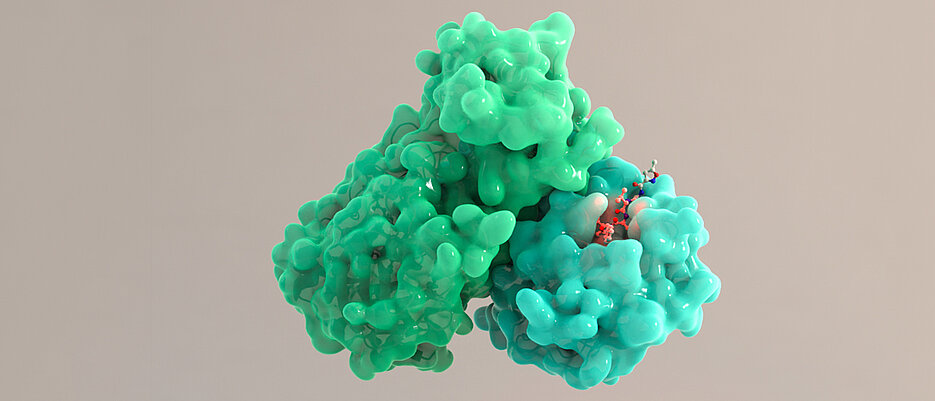Coronavirus: finding the weak spot
04/20/2020Dr. Andrea Thorn, a structural biologist from Würzburg, is leading an international coronavirus research network. The results of her work are important for developing vaccines and drugs.

Coronavirus, or more exactly SARS-CoV-2, has the world in its grip. How does the virus manage to bind to cells in the human body? How does it gain entry to the cell? How does it hijack the cell's machinery to make it help to replicate the viral genome? Scientists around the world are working hard to answer these questions. They hope to discover the 'Achilles heel' of the virus as a target for new drugs to block the replication cycle of SARS-CoV-2. Although scientists already know a lot about the virus they still lack detailed knowledge in many areas.
Andrea Thorn and her team aim to provide these missing details. Together they form the "Coronavirus Structural Task Force" – an international network of experts in the field of structural biology. Their goal is to validate our existing knowledge of the molecular structures of coronavirus and to fill knowledge gaps – or as she puts it: "To get the as much as possible out of the data".
Dr. Thorn, how large are the gaps in our knowledge about the coronavirus that is causing the current pandemic? "Unfortunately, much is still unknown. We are still in the dark about many things that happen at the atomic level. However, we do know, for example, that the viral genome encodes 28 proteins that fulfill different tasks when attacking the host cell. They suppress the immune system or reprogram the cell to replicate the virus. But we only know the structures of about half of these 28 proteins - and molecular structures are crucial in identifying and developing potential drug targets. In addition, the virus interacts with around 150 other proteins from the host cell, but we know very little about these interactions."
The art of creating an exact image from experimental data
As their name suggests, structural biologists work to decipher and visualise the exact structure of large biological molecules, such as proteins, at the atomic level. The synchrotron measurements they use do not produce images in the traditional sense. Instead they deliver huge amounts of data, and it is the job of the structural biologists to create three-dimensional molecular models from these data. Bioinformaticians and computational chemists can then use computers to virtually screen these structures against thousands of substances to look for potential active agents that could bind to the respective molecules and block them. In addition, scientists use the structures to draw conclusions about the function of the proteins, for example, how they infect host cells.
SARS research stopped too soon
Research in this field is gaining momentum as the novel coronavirus continues to spread. Each week, Andrea Thorn and her team are supplied with information about new structures which they computationally. At the same time, they sift through existing data, check their validity or improve existing structural solutions. Coronaviruses, and the SARS virus in particular, are not new discoveries. In 2002/2003, a SARS virus triggered a pandemic that killed almost 800 people worldwide. After the number of new infections had decreased significantly in the summer of 2003, the WHO declared the pandemic over on 19 May 2004.
Dr. Thorn, the coronavirus we are dealing with today is not entirely new. Is this advantageous for your work? "The two SARS coronaviruses are actually very similar in their genome and molecular structures. The fact that the progression of the disease and spread are so fundamentally different is due to their subtle differences. So, we are working hard to identify those differences at the structural level. Unfortunately, SARS virus research was cut back again after the pandemic ended 15 years ago. If the research activities had been continued, we might already have an effective drug for treatment available today."
Looking for a suitable drug
Andrea Thorn wants to research such a drug in the near future. Together with colleagues from Lübeck and Berlin, she has applied to the Federal Ministry of Education and Research for funding. The team has its focus on one particular protease – an enzyme from the coronavirus that enables replication in the host cell. The scientists hope that drug screening will help them identify a substance that inhibits this protease. This would prevent the virus from making more copies of itself.
Andrea Thorn cannot say when the coronavirus pandemic will be over. But she has a clear picture of what the future after the coronavirus crisis will look like from a scientific point of view: "Already in the few weeks since the task force was established, we have seen the different working groups band together. Structural biologists and modelling experts have come together to build a new knowledge base and to improved their methods. These experiences can be transferred to future projects."
Vita
Andrea Thorn studied Molecular Science at the University of Erlangen and subsequently earned her doctorate at the University of Göttingen. Her academic career has taken her to Cambridge, Oxford and the University of Hamburg. Since 2019, she has been an associate group leader at the Rudolf Virchow Center of the University of Würzburg as part of Professor Hermann Schindelin's research group. Her group develops methods and software to extract structures from experimental data.
Andrea Thorn launched the Coronavirus Structural Task Force shortly after the World Health Organization (WHO) declared the new coronavirus a pandemic. Using the combined knowledge and skills of structural biology, she wants to help stop the virus.
Contact
Dr. Andrea Thorn, T: +49 931 31-83677, andrea.thorn@virchow.uni-wuerzburg.de






